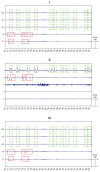Optimizing EEG Signal Integrity: A Comprehensive Guide to Ocular Artifact Correction
- PMID: 39451394
- PMCID: PMC11505294
- DOI: 10.3390/bioengineering11101018
Optimizing EEG Signal Integrity: A Comprehensive Guide to Ocular Artifact Correction
Abstract
Ocular artifacts, including blinks and saccades, pose significant challenges in the analysis of electroencephalographic (EEG) data, often obscuring crucial neural signals. This tutorial provides a comprehensive guide to the most effective methods for correcting these artifacts, with a focus on algorithms designed for both laboratory and real-world settings. We review traditional approaches, such as regression-based techniques and Independent Component Analysis (ICA), alongside more advanced methods like Artifact Subspace Reconstruction (ASR) and deep learning-based algorithms. Through detailed step-by-step instructions and comparative analysis, this tutorial equips researchers with the tools necessary to maintain the integrity of EEG data, ensuring accurate and reliable results in neurophysiological studies. The strategies discussed are particularly relevant for wearable EEG systems and real-time applications, reflecting the growing demand for robust and adaptable solutions in applied neuroscience.
Keywords: EEG; ocular artifacts; signal processing.
Conflict of interest statement
The authors declare no conflicts of interest.
Figures








References
-
- Aricò P., Reynal M., Di Flumeri G., Borghini G., Sciaraffa N., Imbert J.-P., Hurter C., Terenzi M., Ferreira A., Pozzi S., et al. How Neurophysiological Measures Can be Used to Enhance the Evaluation of Remote Tower Solutions. Front. Hum. Neurosci. 2019;13:303. doi: 10.3389/fnhum.2019.00303. - DOI - PMC - PubMed
-
- Capotorto R., Ronca V., Sciaraffa N., Borghini G., Di Flumeri G., Mezzadri L., Vozzi A., Giorgi A., Germano D., Babiloni F., et al. Cooperation objective evaluation in aviation: Validation and comparison of two novel approaches in simulated environment. Front. Neurosci. 2024;18:1409322. doi: 10.3389/fninf.2024.1409322. - DOI - PMC - PubMed
-
- Ozdemir M.A., Kizilisik S., Guren O. Removal of Ocular Artifacts in EEG Using Deep Learning; Proceedings of the 2022 Medical Technologies Congress (TIPTEKNO); Antalya, Turkey. 31 October–2 November 2022; - DOI
-
- Yang B., Duan K., Fan C., Hu C., Wang J. Automatic ocular artifacts removal in EEG using deep learning. Biomed. Signal Process. Control. 2018;43:148–158. doi: 10.1016/j.bspc.2018.02.021. - DOI
Grants and funding
LinkOut - more resources
Full Text Sources
Miscellaneous

